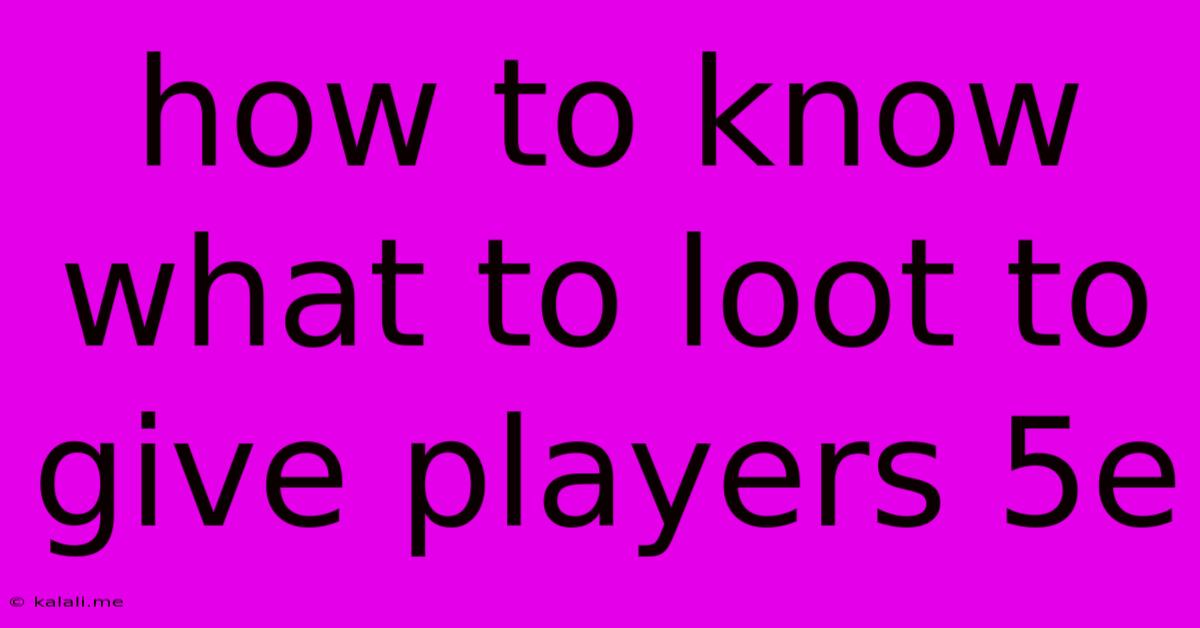How To Know What To Loot To Give Players 5e
Kalali
Jun 01, 2025 · 4 min read

Table of Contents
How to Know What to Loot to Give Players in D&D 5e
This article delves into the crucial aspect of Dungeon Master (DM)ing: designing compelling loot that enhances player experience and game balance in Dungeons & Dragons 5th Edition (5e). Knowing what treasures to bestow upon your adventurers requires more than just randomly rolling dice; it's about understanding your players, your campaign, and the narrative you're weaving. This guide provides strategies and considerations for crafting loot that's both rewarding and meaningful.
Understanding Your Players and Their Playstyle
Before you even think about gold pieces or magic items, consider your players' characters. What are their classes? What are their strengths and weaknesses? A rogue will appreciate different loot than a paladin.
- Optimizers: Players who meticulously plan their builds will appreciate powerful, specific items that enhance their character’s abilities.
- Roleplayers: These players prioritize narrative immersion and will value items with strong story implications or unique properties, even if not the most powerful mechanically.
- Explorers: These players are eager to discover secrets and uncover lore. Clues, maps, and historical artifacts could be far more appealing than simple treasure.
Tailor your loot drops to these individual preferences. Don't just give everyone the same generic magic sword. Think about what will truly excite each player at your table.
Integrating Loot into Your Narrative
Loot shouldn't feel like a random handout; it should be a natural part of the story. Consider these approaches:
- Environmental Storytelling: The environment itself can dictate the type of loot found. A goblin cave might yield rusty weapons and trinkets, while a dragon's hoard will feature glittering gold and powerful magic items.
- Monster-Specific Rewards: The defeated creature's nature should inform its treasure. A powerful wizard might drop a spellbook, while a monstrous beast might possess valuable materials for crafting.
- Plot-Relevant Items: Include items that directly impact the overarching narrative. A key to unlock a secret door, a journal detailing a forgotten prophecy, or a magical amulet needed to defeat a villain. These items maintain engagement and provide a sense of purpose.
Balancing Power and Challenge
Giving players excessively powerful loot too early can break the game’s balance. Similarly, giving them underwhelming loot can lead to frustration. Here's a balanced approach:
- Treasure Hoards: Large treasure hoards should be reserved for significant victories or major milestones in your campaign. This creates a sense of accomplishment.
- Gradually Increasing Power: The potency of loot should generally increase alongside the characters' level and the challenges they face. Early game loot should be less powerful than late game loot.
- Currency Considerations: Don't forget the importance of gold! Gold allows players to purchase equipment, services, and information. This is a vital part of their progression.
Types of Loot Beyond Gold and Magic Items
Don't limit yourself to the typical gold and magic items. Consider these less conventional rewards:
- Information: Maps, cryptic messages, or even a friendly NPC who provides valuable information can be as valuable as any magic item.
- Contacts and Alliances: A powerful ally or a contact within a shady organization can significantly alter the course of the campaign.
- Magical Components: These aren't usable on their own, but they are crucial for crafting or enchanting powerful items later in the campaign.
- Cursed Items: These items may offer benefits but come with significant downsides, adding layers of complexity and risk to the game.
Creating Memorable Loot
The most memorable loot tells a story. It has history and significance beyond its mechanical function. Consider these elements:
- Unique Properties: Give items unique properties, not just stats. A sword that sings when it thirsts for blood, a ring that whispers secrets, a cloak that camouflages the wearer.
- Backstories: Every significant item should have a history – who made it, what it has been used for, and how it got where it is now.
- Visual Description: Engage all the senses when describing loot. What color is it? What does it feel like to the touch? What sounds does it make?
By following these guidelines, you can create exciting and engaging loot that enhances your players’ experience and seamlessly integrates into your D&D 5e campaign, ultimately creating a more immersive and rewarding adventure.
Latest Posts
Latest Posts
-
Mac Os 13 4 Mail Prevent Mail Form Loading Automatically
Jun 02, 2025
-
Question That Cant Possibly Be Answered No
Jun 02, 2025
-
Hope This Email Finds You Well Meaning
Jun 02, 2025
-
Where Did The Term Christian Come From
Jun 02, 2025
-
Only Merging Features May Be Patterned
Jun 02, 2025
Related Post
Thank you for visiting our website which covers about How To Know What To Loot To Give Players 5e . We hope the information provided has been useful to you. Feel free to contact us if you have any questions or need further assistance. See you next time and don't miss to bookmark.